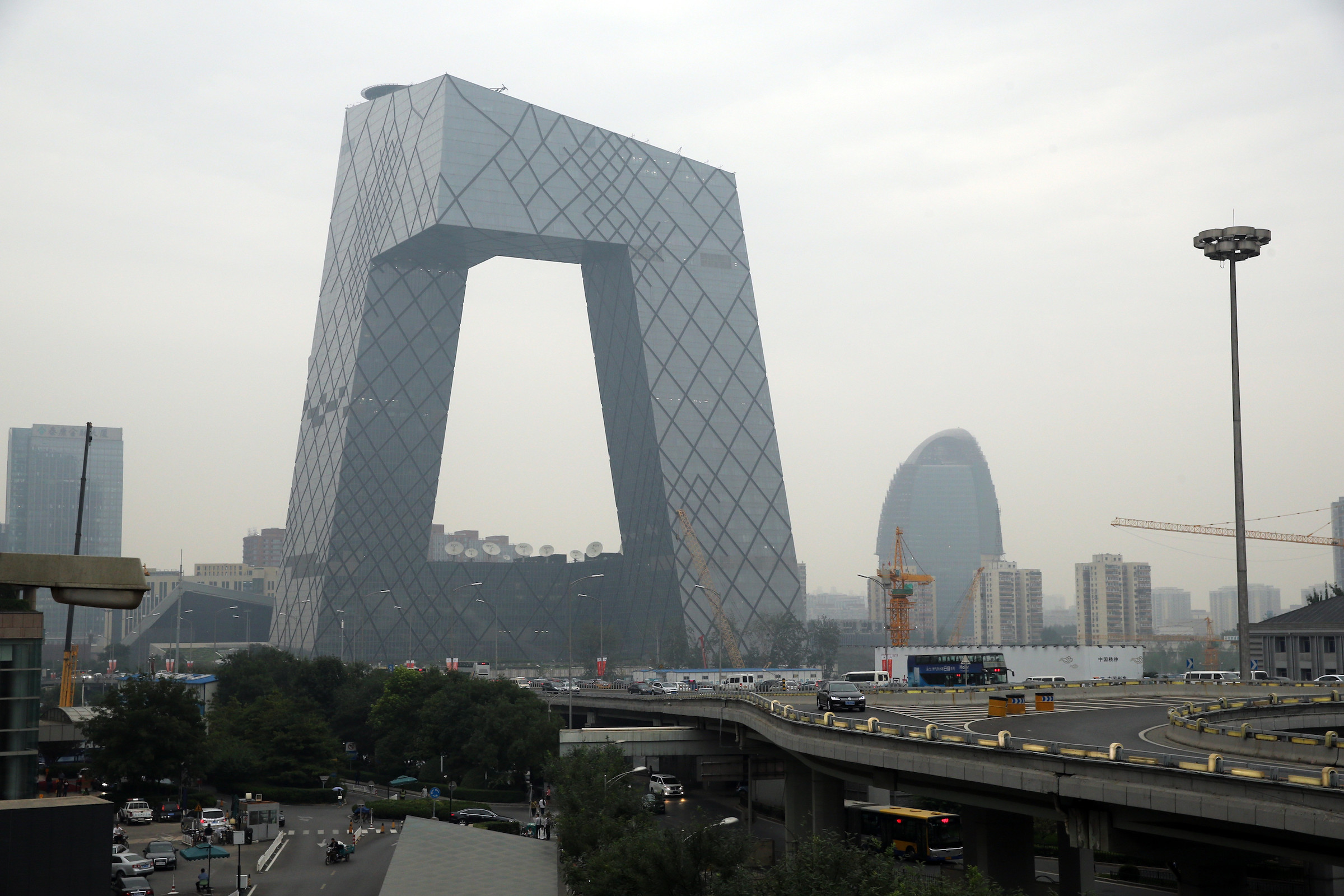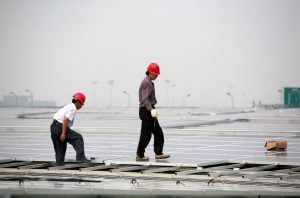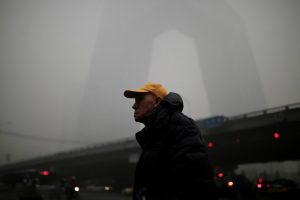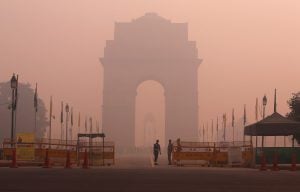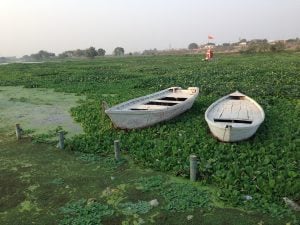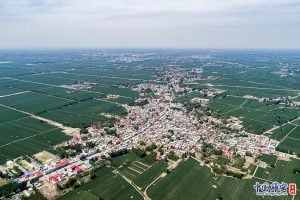China’s new plan for tackling air pollution (published on July 3) is more detailed and covers more cities than the one which expired at the end of 2017 – but it does not set tougher targets than those already in place.
The expiring action plan
The earlier Air Pollution Action Plan, released in September 2013, may have been China’s most influential environmental policy of the past five years. It helped China to make significant improvements to air quality by setting PM2.5 targets for key regions, requiring significant reductions between 2013 and 2017 – of 15% in the Pearl River Delta, and of 33% in Beijing.
In Beijing this meant reducing PM2.5 levels from 89.5µg/m³ (micrograms per cubic metre) down to 60. To do so, Beijing closed its coal-fired power stations, and banned people in surrounding areas from burning coal for heat. These measures were costly and controversial, but they enabled the city to achieve an annual average PM2.5 level of 58µg/m³ – a drop of 35%.
Other cities and provinces also had to act. In the end, China’s three biggest city clusters (Beijing-Tianjin-Hebei, and the Pearl and Yangtze deltas) all beat their targets.
But even so, no Chinese city yet reaches the World Health Organization’s recommended annual average PM2.5 level of 10µg/m³. And as of the end of 2017, only 107 of China’s 338 cities of prefectural level or higher had reached the WHO’s interim standard of 35µg/m³.
The successes of the previous five years and the remaining distance to be travelled left both the public and environmentalists keen to see how China would continue its campaign for “bluer skies”.
Wider scope, safe targets
The new 2018-2020 Three-year Action Plan for Winning the Blue Sky War (the Three-year Action Plan below) is regarded by many as the second phase of the original air pollution action plan.
The new plan matches the PM2.5 target published in 2016 as part of the 13th Five-Year Plan for environmental protection: mandating falls of at least 18% in PM2.5 levels on a 2015 baseline in cities of prefectural or higher level, and where standards have not already been met.
It’s worth noting the phrase, “where standards have not already been met”, as well as the 2015 baseline and target of an 18% fall.
Official data shows that of the 338 cities that are prefectural or higher level, 231 have not yet reached the Chinese government standard on PM2.5 levels, which allows an average of 35µg/m³ (equivalent to the WHO’s interim standard).
The Three-year Action Plan will apply to all these cities. In comparison, the 2013 Action Plan only set PM2.5 targets for the city clusters of Beijing-Tianjin-Hebei and the Pearl and Yangtze Deltas.
According to Huang Wei, climate and energy head for Greenpeace East Asia, the new plan significantly expands the scope of PM2.5 restrictions, with cities previously not covered now under pressure to tackle air pollution.
It seems odd that data from the end of the first plan in 2017 is not used as a baseline (instead of the 2015 baseline).
However, Wang Jinnan, head of the Ministry of Ecology and Environment’s Chinese Academy of Environmental Planning and a member of the Chinese Academy of Engineering, said that setting another target outside of the 13th Five-Year Plan framework (which runs 2016 to 2020) would create confusion for local governments. Therefore, no new quantitative targets have been set. Instead, the plan reiterates the need to meet the goals of the 13th Five-Year Plan.
For some cities, the 2016 target to reduce PM2.5 pollution by 18% by 2020 looks too easy.
Over 70 cities have reduced air pollution so much over the course of the first action plan that the new target has already been met. So for these cities the new plan will provide no motivation to do more. Furthermore, the target is weaker than some cities set themselves as part of their own 13th Five Year Plans (see table below).
However, cities that have not previously been subject to these action plans, such as Linfen in Shanxi, will be forced to improve their air quality.
It’s also worth noting that even if all cities achieve the 18% reduction target, there will still be over 200 cities that do not meet the national 35µg/m³ standard in 2020, and the Three-year Action Plan provides no indication of when they might do so.
Ozone in focus
The new action plan focuses more on ozone, which is created when volatile organic compounds (VOCs) react with nitrogen oxides. It adds targets for both VOCs and nitrogen oxides; emissions reductions of 10% and 15%, respectively, by 2020 (again on a 2015 baseline).
Although ozone in the upper atmosphere blocks damaging ultraviolet radiation, ground-level ozone can cause respiratory problems.
Experts say ozone pollution in China is not particularly severe when compared to other countries. Hao Jiming, a professor at Tsinghua University’s School of the Environment and a member of the Chinese Academy of Engineering, told China Dialogue that ozone levels have risen somewhat, but remain within an acceptable range.
11%
The increase in average levels of ozone pollution in China nationwide, 2017-2018
But there are signs that ozone pollution in China is worsening. Higher temperatures mean more ozone is created. In the hot and humid Pearl River Delta, ozone is now the primary pollutant, rather than PM2.5. Many other regions also suffer from ozone pollution during the summer months. Greenpeace has calculated that average ozone levels nationwide in June were 11% higher than the previous year.
Zhang Jianyu, chief representative at the Beijing office of the Environmental Defense Fund, a US non-governmental organisation, told China Dialogue that in the US the problem of ground-level ozone pollution became a more prominent public health issue once initial progress was made in tackling particulate pollution. He explained that the US reduced ozone levels by placing a cap on nitrogen oxide emissions and, in 2015, toughening limits on ozone levels.
By setting clear targets, China’s new plan represents a further improvement in the country’s air management policies.
Another key ‘rust-belt’ battleground
A notable change in the new plan is a shift in the battle for “blue skies” – the Pearl River Delta is no longer described as a key region. Instead, it’s been replaced by the Fen-Wei plain, which includes Xi’an and parts of Shaanxi, Henan and Shanxi provinces.
The Fen-Wei plain suffers from the country’s highest levels of sulphur dioxide pollution, while PM2.5 levels are also among the highest nationwide.
Li Ganjie, head of the Ministry of Ecology and Environment, has said that while other key regions have experienced sustained improvements in air quality, the Fen-Wei plain has worsened and much more effort is needed. In the region’s major city, Xi’an, PM2.5 levels increased 27% between 2015 and 2017, a worrying trend.
Like Hebei, which forms part of the Beijing-Tianjin-Hebei region, this region relies on coal for energy and is home to polluting heavy industries. The Three-year Action Plan requires coal consumption to fall here by 2020, bans the small-scale burning of coal for heat in winter, and will see a full shake-up of polluting industries by 2019.
Fu Lu, China director for Clean Air Asia, said that the Fen-Wei plain’s new status would mean tougher evaluations of local government performance by central government, but also more financial and technical support, boosting resource allocation and capability in these poorer areas.
Climate impacts
After the reforms of 2018, the National Development and Reform Commission’s climate change and carbon emission responsibilities shifted to the Ministry of Ecology and Environment. The Three-year Action Plan, meanwhile, indicates that China’s management of air pollution and climate change are coming together.
The plan calls explicitly for “large reductions in total emissions of major pollutants in coordination with reduction in emissions of greenhouse gases.”
The Three-year Action Plan continues to strengthen end-of-pipe treatment, but also takes more detailed measures on the sources of pollution and structural issues, including transitions in energy, industrial and transportation. For example, there are 11 indices and measures for the Fen-Wei plain, including total coal consumption, the proportion of freight carried by train, and clean heating.
After an exhausting five-year sprint, China is settling in for a long and steady jog.
Those measures arose from targeted research. The Ministry of Ecology and Environment’s research bodies evaluated the climate co-benefits from various approaches to tackling urban air pollution.
The measures with the greatest co-benefits were then proposed. For example, better district heating in northern industrial cities, cleaner heating furnaces, and tackling small-scale coal burning.
The new plan is backed up by more research and experience than its predecessor. He Kebin, a member of the Chinese Academy of Engineering and dean of Tsinghua University’s School of the Environment, said that evaluations carried out after the first action plan expired had identified the sources of smog and its constituents down to the sector-level – energy, industry, transportation, and so on – with the aim of enabling more scientific and targeted methods.
After an exhausting five-year sprint, China is settling in for a long and steady jog.
